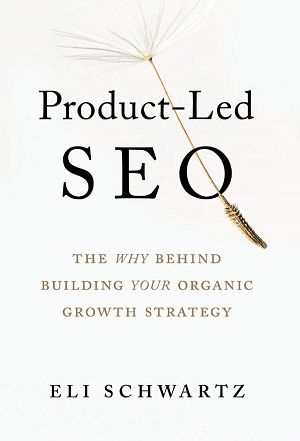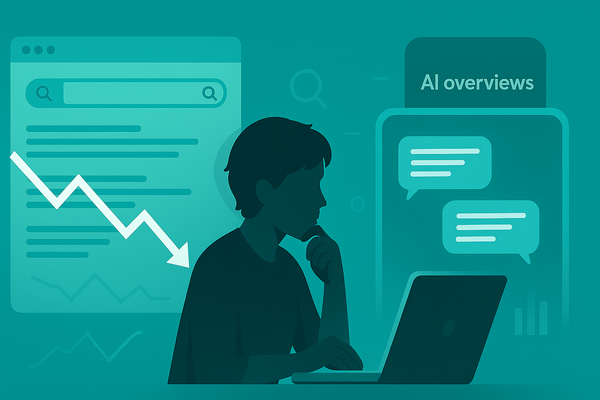Product-Led SEO: Book Summary and Notes
Product-Led SEO is a book about first-principle thinking in SEO. Instead of sharing ineffective tactics or analyzing Google guidelines like in most SEO books, Eli Schwartz put together a practical book with (as it looks like) timeless principles of search.

Most SEO books and articles are discussing up-and-coming tactics which everyone is already utilizing. These resources are the straightforward way to achieve mediocre results even if you do anything based on best practices.
Yet here is a book that shares some practical tips but what it is strong in is strategy.
The author, Eli Schwartz has led the SEO team in SurveyMonkey and worked together with websites like Quora, Zendesk, and Mixpanel. Schwartz has practical experience with the nuances of SEO but in his book, he also took a step back and is explaining the basics of SEO in an unexpectedly easy-to-understand way.
Product-Led SEO is not a general book about SEO. It serves a special audience: product managers, engineers, and SEOs working on scalable products. This is not a book for small business owners and this is one of the big advantages of it.
If you are curious about how to frame SEO initiatives to get stuff done, what kind of metrics should you use to measure SEO, and why SEO won’t be automated in the future then Product-Led SEO will be a good read for you.
I summarized the ideas in the book which most resonated with me chapter by chapter. This is not a comprehensive summary and you can learn much more from the book.
1. The Basics of SEO and How Search Works
- What is Product-Led SEO? Search engines want to show the best results for users. Product-Led SEO is capitalizing on this principle. Instead of blindly following search volume data or writing content for keywords everyone else is targeting, product-led SEO is focusing on user needs first and using search engines only as a medium.
- How to build SEO into products? First, you have to know what search engines are looking for when evaluating your site. Then translate those requirements into recommendations that product managers and engineers can build into the product.
- SEO is a zero-sum game: If one site gets the click, the other gets significantly less if it receives clicks at all. SEO is a finite game.
- Keyword research will become obsolete: Keyword research is not as useful as it used to be. The importance of keyword research will further decline with updates and new innovations.
- Intent-driven keyword research: The intent of keywords will be more important than other metrics (and it's already happening).
- The first step is not enough: If a page is crawled it does not mean Google will index it. If a page is indexed, it does not mean it will automatically rank.
- When should you fear an algorithm update? Based on Eli Schwartz's opinion you should only fear a Google update if you are not providing a good enough experience for users coming from Google search. If that’s not the case, then updates should probably help you (I find this in some cases true, but most of the updates I experienced did not follow any logic).
Google algorithms
There is no one definite Google algorithm rather there are parallelly running and continuously changing different algorithms. The most important ones are managing discovery, crawling, indexing and ranking.
- 1. Discovery: Google is crawling the web to discover new sites and pages which weren't indexed before.
- 2. Crawling: Once a site is discovered, the algorithm needs to decide how valuable it is, how much effort should it allocate to the site.
- 3. Indexing: The indexing algorithm labels and categorizes the worthy content. During indexation, Google not only decides whether to include content in search results, but in which bucket it should display.
- 4. Ranking: After the first three algorithms of Google find the content good enough to include in the search results pages, then comes the ranking algorithm. It categorizes the pages and evaluates its score on which bases it will be shown in different positions for given queries.
Five factors driving ranking scores
- The intent of the query
- Relevance of the page to the query
- Quality of the content
- Usability of the page: mobile-friendliness, page speed, UX
- Context and settings: location and time signals
2. What Is Product-Led SEO?
- Win without keywords: Product-Led SEO is not about winning for any specific keyword but winning for many possible keywords even if there is no demand for them currently.
- Find future demand, not keywords: Traditional keyword research is not the best tool for validation if you want to achieve real success. For existing queries, there is too much competition already. But if you identify future needs and create a search-driven solution then you will have a competitive advantage of leveraging future demand.
- Focus on non-branded search: Branded searches grow just as much as the brand grows. However, non-branded searches have an infinite potential (or at least you can target with non-branded queries a much bigger target group).
3. SEO Is a Job for Humans
- SEO is a human job: SEO can’t be automated and SEO’s can’t be replaced 100% with tools or automation. The end-user of search engines will always be humans, and the human element will always be needed to understand the motives behind data.
- SEO tools are not the answer: SEO tools like Moz, Ahrefs, SEMrush, Conductor, Clarity, and Searchmetrics improved a lot but their metrics do not have a straightforward next step. Human intellect is needed to make sense of those numbers.
- Skills of SEOs: The author divides SEO practitioners into 4 distinct areas: Product management, copywriting, technical SEO, and PR.
“A robot can certainly build a perfect set of blueprints to spec—but it can’t translate desire into a plan.”
4. SEO and Digital Marketing
- SEO should follow business metrics: The primary SEO metrics should always be business metrics which the company uses to evaluate the effectiveness of other marketing channels as well. (In short: instead of visibility and ranking use revenue and signups accredited to SEO.)
- The Three Levels of SEO Performance: The first step in SEO is to appear at all in search. That's Impression. Users need to click on those results. That’s Clicks. But for most businesses Conversions are the metrics that move the needle
- SEO Personas: Building SEO personas (the right way) is not a wasted effort. Where are the users in the funnel and how do they search during that phase? Use these questions to create SEO personas.
- The desktop will always stay: The author argues that for some type of online shopping (like buying expensive software) a desktop with a bigger screen will be always needed. (Desktop searches are for sure part of the funnel for now, but I doubt that it will stay this way.)
“Attracting traffic that won’t convert becomes an expensive hobby.”
5. Strategic SEO
- Red ocean in SEO: SEO strategies too often start with keyword research. Everyone is targeting the same queries and due to the zero-sum nature of SEO, only a handful of players will realize a return on their investment.
- Blue ocean in SEO: Product-Led SEO is capitalizing on user needs. There are no keywords with existing demand to back up a product-led SEO initiative. The only thing we can build upon is a hypothesis about what users need and customer research we are using to identify those needs.
- Compounding: SEO is the best place to see the effects of compounding within marketing.
- Early-stage companies should not prioritize SEO: Eli Schwartz suggests that most early-stage companies should not prioritize SEO. SEO is a slowly growing channel. If your life depends on reaching tangible milestones in a short amount of time then you will go bankrupt before the compounding effect of SEO kicks in.
6. Tactical SEO
- Google Algorithm is working like academia: Google has modeled its algorithm after the authority-driven system of academia. Academic papers are considered to be trustworthy if a large number of other papers are referring to them. The same goes for websites, just the mentions mean links.
- Build linkable assets: Instead of working hard on generating backlinks (mostly with guest posts and paid link placements) you should build linkability into your product. Write content and create products that others are happy to refer to. (I find this generally good advice, but when your competitors are using both techniques then you do not have any other choice than to leverage every source of backlinks.)
- Test linkability with social media: We know that social media do not provide quality backlinks but you can use it to test your content. If your content is resonating and attracting shares in social media then it is likely to get backlinks as well.
- Users favor brands in search: Google has been accused that are preferring brands in search. But users are preferring brands as well, so maybe this does make sense.
- Random internal links: Add randomly updated links to your website to achieve better results with your linking strategy.
- HTML sitemaps: However Google suggested that HTML sitemaps are not necessary, the author found them effective for large sites.
- Crawl budget: For a website with a high number of pages, one of the best things to do to ensure Google is crawling and indexing important pages is to block low-quality pages.
- Crawl budget optimization with Happy Meal: Eli Schwartz uses the best example I have ever encountered to make the case for crawl budget optimization. Let's assume you have a certain amount of budget to buy a Happy Meal every day and you want some specific toys to complete your collection. Every day when you get a toy you already own, the day's budget is wasted. But if you could take out the duplicated toys from your future purchases then you could get (or in the case of Google: crawl) the toys you want for sure.
7. Broad SEO Categories
- Mobile Search: With the rise of mobile devices some SEOs think you may need a different Mobile SEO Strategy. (I found this trend relevant not just for the future but for the present. Look at mobile-first indexing, optimizing for Google Discover or image thumbnails present just on mobile devices. All of these are worth optimizing for and are present only in the mobile search results).
- Voice Search: The author is advocating that voice search won’t replace traditional search because with voice it is harder to find the right queries and there are no auto-completed suggestions. Also it is harder to monetize only 1 result which would be bad for Google. (Voice Search has been a “disrupting technology” since 2016 but still isn’t widespread. Eli Schwart provides some great reasons why this disruption may never happen.)
8. The Company and SEO
- Focus on small wins: In the process-driven culture of large companies, you should focus on small incremental wins. Small wins will have a compounding effect.
- The ranking is a vanity metric: Measuring ranking is the wrong way to measure the results of SEO. SEO should be measured as any other product: by adoption and engagement.
- Build instead of fix for SEO: Instead of asking engineers to fix bugs to comply with SEO requirements ask them to build something for SEO.
"As anyone who has ever worked on SEO at scale knows, getting to the ideal state on all SEO factors is like climbing a mountain…at night…in a snowstorm…while you’re half-frozen. You know the peak is somewhere up there, and you just need to keep trudging forward."
9. Implementing Product-Led SEO
- Involve stakeholders first: Involve designers, customer service, and every stakeholder during ideation. You can avoid building something which will require major redesign later and get their buy-in at the same time.
- Avoid keyword-driven content: Writing content based on keyword research is what everyone else is doing. If you don’t have any competitive advantage you should avoid that at all costs.
- Always bring numbers: Even if you have only rough estimations, you should try to come up with numbers to support you getting resources. Everyone asking for resources is doing the same.
- SEO is a long-term investment: As you pitch SEO initiatives you should be upfront about the nature of SEO. May you don't see any significant impact for months to come but after that, you can realize a measurable impact for years. Emphasize both aspects.
- The best type of Product-Led SEO efforts: The most successful SEO initiatives are programmatically combining several data sources and can iterate later.




